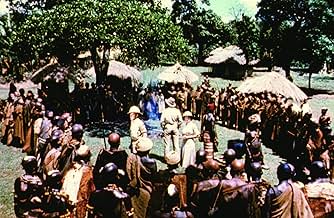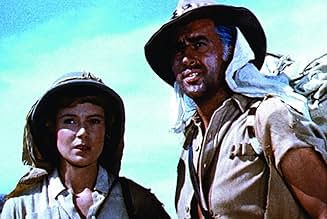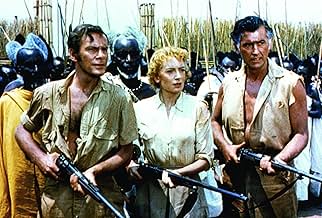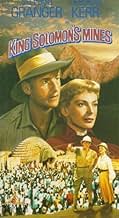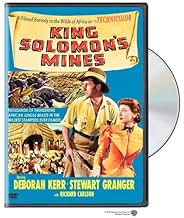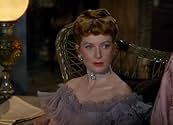L'avventuriero Allan Quartermain guida una spedizione in territori africani inesplorati nel tentativo di individuare un esploratore scomparso durante la sua ricerca delle leggendarie miniere... Leggi tuttoL'avventuriero Allan Quartermain guida una spedizione in territori africani inesplorati nel tentativo di individuare un esploratore scomparso durante la sua ricerca delle leggendarie miniere di diamanti del re Salomone.L'avventuriero Allan Quartermain guida una spedizione in territori africani inesplorati nel tentativo di individuare un esploratore scomparso durante la sua ricerca delle leggendarie miniere di diamanti del re Salomone.
- Regia
- Sceneggiatura
- Star
- Vincitore di 2 Oscar
- 4 vittorie e 2 candidature totali
- Chief Gagool
- (as Sekaryongo of the Watussi Tribe)
- King Twala
- (as Baziga of the Watussi Tribe)
- Chief Bilu
- (non citato nei titoli originali)
- Austin - Safari Client
- (non citato nei titoli originali)
- Black Circle
- (non citato nei titoli originali)
- Kafa - Umbopa's Old Uncle
- (non citato nei titoli originali)
- Traum - Safari Client
- (non citato nei titoli originali)
Recensioni in evidenza
Secondly, the MGM crew of about 30 people and 7 cargo trucks spent months in 1949 filming this on the Dark Continent itself, at locations hundreds of miles from civilization in eastern Africa instead of the usual Hollywood lots. They enlisted the inhabitants of remote villages as actors, asked them to perform communal dances, and took many close-up shots of their faces, hair, headgear, jewelry and body paint. This amounts to some of the most magnificent - and rare - color and sound footage of "old" untouched African culture I've seen.
Not long after this, during the 1950's-1960's these villages gradually became part of the modern world, and by the 1980's, remote tribesmen were filmed as they hunted with spears - wearing "Michael Jackson" t- shirts.
The movie is generally pretty good, but the Africans steal the show.
The film is very exciting. And you feel for the characters when they come into contact with danger. I wish more action films could make you do that. The performances are the reason behind this. It's too bad that the actors and actresses in the film weren't nominated for Oscars. I doubt they deserved to win, but they deserved to be up.
The script is also very good. It strays away from the book just a little bit. But I have no problem with that because the film, by itself, is very good.
The cinematography and editing are flawless. And they rightly won Oscars. The film was also nominated for Best Picture. It's one of the better adventure films.
Let me mention just one striking 'detail': what's going on on screen is SO fascinating that no music has been added to the various sounds emanating from the country or from the music instruments of the African people themselves. This was a daring move, especially at the time, but it enriched the movie enormously.
I will end this quick review with a piece of advice: Your mind should be as free as possible from everyday's life various troubles if you want to enjoy this movie. Pick up a night when you are already rather relaxed, and immerse yourself gently into the atmosphere created by the filmmakers. You won't regret it.
The filming started in Africa 1949, running time five months. The crew travelled by hundred miles in planes and trucks across Kenia, Uganda, Congo Belgian, Lagoon Victory, Falls of Murchisin and north of lagoon Tanganika where live the Watusi. Polished and coloristic production design by the veteran Cedric Gibbons. Heat and ills affected the crew and main actors but Deborah Kerr surprised for her resistance. There had confronting between Stewart Granger and Compton Bennett and Andrew Marton directed the second unity. Then, Metro Goldwyn Mayer dismissed Compton and Marton finished the picture. It was nominated for best movie and won Academy Award for cinematography by Robert Surtees and edition. Had several take-out with no use and later Metro Goldwyn Mayer utilized for its follow-up.
The picture is followed by a sequel, rapidly made, created with excess footage previous, titled 'Watusi'(1959) by Kurt Neumann with George Montgomery and David Farrar. An inferior version directed by J.Lee Thompson(1985) with Richard Chamberlain and Sharon Stone; and a TV adaptation directed by Steven Boyum with Patrick Swayze and Alison Doody, among others.
Lo sapevi?
- QuizThe elephant stampede sequence in the film was reshot in Hollywood using a trained elephant, as the footage of the actual stampede in Africa was lost when the cast and crew of the film fled from the deadly rush of the animals.
- BlooperThe elephant that charges the hunter and guide is an African elephant. The one that picks the guide up and tosses him over its shoulder is a trained Indian elephant. African elephants are too aggressive to be trained for such stunts.
- Citazioni
Allan Quatermain: Mrs. Curtis, the average life of a man in my profession is approximately eight years. Now, I've been at it for fifteen, so you see, I've been living on borrowed time. My wife died here six years ago. Sooner or later, an animal, or an unfriendly native, or a tropical disease will get me. I have a son in England. There'll be very little money for him if anything should happen to me in the ORDINARY course of events, but the money you're offering would provide very nicely for the boy until he's old enough to take care of himself.
- ConnessioniEdited into Vatussi (1959)
I più visti
Dettagli
- Data di uscita
- Paese di origine
- Lingua
- Celebre anche come
- Las minas del rey Salomón
- Luoghi delle riprese
- Azienda produttrice
- Vedi altri crediti dell’azienda su IMDbPro
Botteghino
- Budget
- 2.258.000 USD (previsto)
- Lordo in tutto il mondo
- 951 USD
- Tempo di esecuzione
- 1h 43min(103 min)
- Colore
- Proporzioni
- 1.37 : 1


